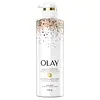What's inside
What's inside
 Key Ingredients
Key Ingredients

 Benefits
Benefits

 Concerns
Concerns

 Ingredients Side-by-side
Ingredients Side-by-side

Water
Skin ConditioningSodium Trideceth Sulfate
CleansingSodium Chloride
MaskingPetrolatum
EmollientCocamidopropyl Betaine
CleansingHydrated Silica
AbrasiveTrideceth-3
EmulsifyingParfum
MaskingNiacinamide
SmoothingSaccharum Officinarum Extract
MoisturisingTheobroma Cacao Seed Butter
EmollientSodium Citrate
BufferingGuar Hydroxypropyltrimonium Chloride
Skin ConditioningCitric Acid
BufferingSodium Benzoate
MaskingXanthan Gum
EmulsifyingStearyl Stearate
EmollientDisodium EDTA
Sodium Hydroxide
BufferingGlyceryl Oleate
EmollientAcrylates/C10-30 Alkyl Acrylate Crosspolymer
Emulsion StabilisingEuphorbia Cerifera Wax
Jojoba Esters
EmollientMethylchloroisothiazolinone
PreservativeMethylisothiazolinone
PreservativeIron Oxides
Water, Sodium Trideceth Sulfate, Sodium Chloride, Petrolatum, Cocamidopropyl Betaine, Hydrated Silica, Trideceth-3, Parfum, Niacinamide, Saccharum Officinarum Extract, Theobroma Cacao Seed Butter, Sodium Citrate, Guar Hydroxypropyltrimonium Chloride, Citric Acid, Sodium Benzoate, Xanthan Gum, Stearyl Stearate, Disodium EDTA, Sodium Hydroxide, Glyceryl Oleate, Acrylates/C10-30 Alkyl Acrylate Crosspolymer, Euphorbia Cerifera Wax, Jojoba Esters, Methylchloroisothiazolinone, Methylisothiazolinone, Iron Oxides
Water
Skin ConditioningArgania Spinosa Kernel Oil
EmollientCaprylic/Capric Triglyceride
MaskingGlycerin
HumectantCarthamus Tinctorius Seed Oil
MaskingCoco-Caprylate/Caprate
EmollientButyrospermum Parkii Butter
Skin ConditioningCetearyl Olivate
Sorbitan Olivate
EmulsifyingAloe Barbadensis Leaf Juice
Skin ConditioningPhenoxyethanol
PreservativeHydroxyethyl Acrylate/Sodium Acryloyldimethyl Taurate Copolymer
Emulsion StabilisingSclerotium Gum
Emulsion StabilisingHelianthus Annuus Seed Oil
EmollientOctyldodecyl PCA
EmollientSqualane
EmollientEthylhexylglycerin
Skin ConditioningPersea Gratissima Oil
Skin ConditioningCarthamus Tinctorius Oleosomes
EmollientSorbitan Isostearate
EmulsifyingMedicago Sativa Extract
TonicTetrasodium Glutamate Diacetate
Panthenol
Skin ConditioningCamellia Sinensis Leaf Extract
AntimicrobialAllantoin
Skin ConditioningTocopheryl Acetate
AntioxidantLecithin
EmollientSodium Benzoate
MaskingQuercetin
AntioxidantGluconolactone
Skin ConditioningAlkanna Tinctoria Root Extract
Skin ConditioningSodium Hydroxide
BufferingPotassium Sorbate
PreservativeZea Mays Oil
EmulsifyingSymphytum Officinale Leaf Extract
Skin ConditioningBeta-Carotene
Skin ConditioningCitric Acid
BufferingDunaliella Salina Extract
Skin ConditioningOlea Europaea Fruit Oil
MaskingWater, Argania Spinosa Kernel Oil, Caprylic/Capric Triglyceride, Glycerin, Carthamus Tinctorius Seed Oil, Coco-Caprylate/Caprate, Butyrospermum Parkii Butter, Cetearyl Olivate, Sorbitan Olivate, Aloe Barbadensis Leaf Juice, Phenoxyethanol, Hydroxyethyl Acrylate/Sodium Acryloyldimethyl Taurate Copolymer, Sclerotium Gum, Helianthus Annuus Seed Oil, Octyldodecyl PCA, Squalane, Ethylhexylglycerin, Persea Gratissima Oil, Carthamus Tinctorius Oleosomes, Sorbitan Isostearate, Medicago Sativa Extract, Tetrasodium Glutamate Diacetate, Panthenol, Camellia Sinensis Leaf Extract, Allantoin, Tocopheryl Acetate, Lecithin, Sodium Benzoate, Quercetin, Gluconolactone, Alkanna Tinctoria Root Extract, Sodium Hydroxide, Potassium Sorbate, Zea Mays Oil, Symphytum Officinale Leaf Extract, Beta-Carotene, Citric Acid, Dunaliella Salina Extract, Olea Europaea Fruit Oil
Ingredients Explained
These ingredients are found in both products.
Ingredients higher up in an ingredient list are typically present in a larger amount.
Citric Acid is an alpha hydroxy acid (AHA) naturally found in citrus fruits like oranges, lemons, and limes.
Like other AHAs, citric acid can exfoliate skin by breaking down the bonds that hold dead skin cells together. This helps reveal smoother and brighter skin underneath.
However, this exfoliating effect only happens at high concentrations (20%) which can be hard to find in cosmetic products.
Due to this, citric acid is usually included in small amounts as a pH adjuster. This helps keep products slightly more acidic and compatible with skin's natural pH.
In skincare formulas, citric acid can:
While it can provide some skin benefits, research shows lactic acid and glycolic acid are generally more effective and less irritating exfoliants.
Most citric acid used in skincare today is made by fermenting sugars (usually from molasses). This synthetic version is identical to the natural citrus form but easier to stabilize and use in formulations.
Read more about some other popular AHA's here:
Learn more about Citric AcidSodium Benzoate is a preservative. It's used in both cosmetic and food products to inhibit the growth of mold and bacteria. It is typically produced synthetically.
Both the US FDA and EU Health Committee have approved the use of sodium benzoate. In the US, levels of 0.1% (of the total product) are allowed.
Sodium benzoate works as a preservative by inhibiting the growth of bacteria inside of cells. It prevents the cell from fermenting a type of sugar using an enzyme called phosphofructokinase.
It is the salt of benzoic acid. Foods containing sodium benzoate include soda, salad dressings, condiments, fruit juices, wines, and snack foods.
Studies for using ascorbic acid and sodium benzoate in cosmetics are lacking, especially in skincare routines with multiple steps.
We always recommend speaking with a professional, such as a dermatologist, if you have any concerns.
Learn more about Sodium BenzoateSodium Hydroxide is also known as lye or caustic soda. It is used to adjust the pH of products; many ingredients require a specific pH to be effective.
In small amounts, sodium hydroxide is considered safe to use. However, large amounts may cause chemical burns due to its high alkaline.
Your skin has a natural pH and acid mantle. This acid mantle helps prevent harmful bacteria from breaking through. The acid mantle also helps keep your skin hydrated.
"Alkaline" refers to a high pH level. A low pH level would be considered acidic.
Learn more about Sodium HydroxideWater. It's the most common cosmetic ingredient of all. You'll usually see it at the top of ingredient lists, meaning that it makes up the largest part of the product.
So why is it so popular? Water most often acts as a solvent - this means that it helps dissolve other ingredients into the formulation.
You'll also recognize water as that liquid we all need to stay alive. If you see this, drink a glass of water. Stay hydrated!
Learn more about Water